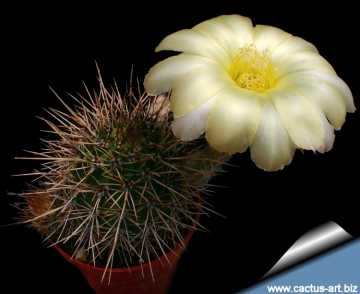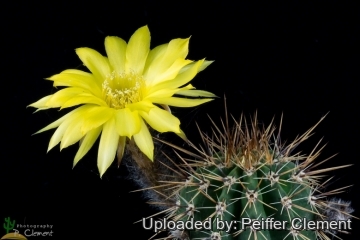= Echinopsis aurea subs. fallax (Oehme) M.Lowry
Cactaceae Syst. Init. 19: 11. 2005 [Mar 2005]
Accepted Scientific Name: Echinopsis aurea Britton & Rose
Cactaceae (Britton & Rose) 3: 74. 1922 [12 Oct 1922] Britton & Rose

Echinopsis aurea var. fallax (Echinopsis aurea subs. fallax) Photo by: Valentino Vallicelli
P137 La Rioja. Argentina. The spines are impressively strong and very showy. The spines of plants in cultivation are usually weaker, because many growers fail to give them full sun exposure.
Origin and Habitat: Northern Argentina.
Synonyms:
See all synonyms of Echinopsis aurea
back
Accepted name in llifle Database:Echinopsis aurea Britton & RoseCactaceae (Britton & Rose) 3: 74. 1922 [12 Oct 1922]Synonymy: 96
back
Description: Echinopsis aureaSN|10643]]SN|10643]] subs. fallax is a solitary or branched subspecies species distinguished by impressively strong and very showy spines.
Stems: Dark green to grey-green, globular or elongated, reaching a height of 15 cm and a diameter of 4 to 10 cm or more.
Ribs: 14 to 15, sharp-edged, separated by deep grooves.
Spines: It has 8 to 10 radials, paler, about 2 cm long pointing outward and, usually, 4 central spines, 3 to 6 cm long. The central spines are thicker, about 4 cm (up to 6cm) long, and brown to black with yellow tips.
Flowers: Lemon yellow and bright yellow inside (nearly 10 cm) long. Blooms in flushes in late spring and occasionally in summer. The buds are covered by long silky hairs and grow laterally from the centre of the stem. The tube is slightly curved, funnel-shaped, slender and greenish white, with pale green scales, red at the base, with white and black below.
More...Subspecies, varieties, forms and cultivars of plants belonging to the Echinopsis aurea group
 Echinopsis aurea Britton & Rose: has large showy yellow flowers. Stem solitary or with many basal and lateral offshoots.This species has a wide range and shows a great variability. Distibution: Northern Argentina and Southern Bolivia.
Echinopsis aurea Britton & Rose: has large showy yellow flowers. Stem solitary or with many basal and lateral offshoots.This species has a wide range and shows a great variability. Distibution: Northern Argentina and Southern Bolivia. Echinopsis aurea var. albiflora (Rausch) J.Ullmann: has pure white flowers.
Echinopsis aurea var. albiflora (Rausch) J.Ullmann: has pure white flowers. Echinopsis aurea var. dobeana (Dölz) J.Ullmann: has red flowers. Distribution: Sierra Ancasti, Catamarca, Argentina.
Echinopsis aurea var. dobeana (Dölz) J.Ullmann: has red flowers. Distribution: Sierra Ancasti, Catamarca, Argentina. Echinopsis aurea subs. fallax (Oehme) M.Lowry: has globular stems with long, stout, sharp spines and produces large yellow flowers. Distibution: widespread in northern Argentina.
Echinopsis aurea subs. fallax (Oehme) M.Lowry: has globular stems with long, stout, sharp spines and produces large yellow flowers. Distibution: widespread in northern Argentina. Echinopsis aurea var. mizquiensis: has compact stems closely covered with fine reddish-brown spines, and huge pale yellow flowers. Distribution: Mizque, dept. Cochabamba, Bolivia.
Echinopsis aurea var. mizquiensis: has compact stems closely covered with fine reddish-brown spines, and huge pale yellow flowers. Distribution: Mizque, dept. Cochabamba, Bolivia. Echinopsis aurea subs. shaferi (Britton & Rose) M.Lowry: has clusterd stems with many basal and lateral offshoots. It is very spiny and produces large pale yellow flowers. Distibution: Mizque, dept. Cochabamba. Bolivia.
Echinopsis aurea subs. shaferi (Britton & Rose) M.Lowry: has clusterd stems with many basal and lateral offshoots. It is very spiny and produces large pale yellow flowers. Distibution: Mizque, dept. Cochabamba. Bolivia. Echinopsis aurea subs. shaferi f. monstruosa cristata hort.: it is the crested form of Echinopsis aurea subs. shaferi f. monstruosa, it may produce yellow mostrous flowers too. .
Echinopsis aurea subs. shaferi f. monstruosa cristata hort.: it is the crested form of Echinopsis aurea subs. shaferi f. monstruosa, it may produce yellow mostrous flowers too. . Echinopsis aurea subs. shaferi f. monstruosa hort.: it is an almost spineless clustering plant with ovoidal growth habit that branches profusely and can slowly grow up to 30 cm tall.
Echinopsis aurea subs. shaferi f. monstruosa hort.: it is an almost spineless clustering plant with ovoidal growth habit that branches profusely and can slowly grow up to 30 cm tall. Echinopsis aurea var. sierragrandensis (Rausch) J.G.Lamb.: has long thin spines and large golden yellow blooms. Distribution: Sierra Grande de Cordoba, Cordoba, Northern Argentina.
Echinopsis aurea var. sierragrandensis (Rausch) J.G.Lamb.: has long thin spines and large golden yellow blooms. Distribution: Sierra Grande de Cordoba, Cordoba, Northern Argentina. Echinopsis leucomalla (Wessner) Friedrich: has compact stems closely covered with fine white spines, and huge pale lemon yellow flowers. Distribution: San Luis and Catamarca, Argentina.
Echinopsis leucomalla (Wessner) Friedrich: has compact stems closely covered with fine white spines, and huge pale lemon yellow flowers. Distribution: San Luis and Catamarca, Argentina.
Notes: There are several varieties of Lobivia (Echiopsis) aurea, with very different spine shapes and lengths.
Bibliography: Major references and further lectures
1) David Hunt, Nigel Taylor “The New Cactus Lexicon” DH Books, 2006 ISBN 0953813444, 9780953813445
2) Edward F. Anderson “The Cactus Family” Timber Press, 2001
3) James Cullen, Sabina G. Knees, H. Suzanne Cubey “The European Garden Flora Flowering Plants: A Manual for the Identification of Plants Cultivated in Europe, Both Out-of-Doors and Under Glass”Cambridge University Press, 11/ago/2011
4) David Hunt, Nigel Taylor “The New Cactus Lexicon” DH Books, 2006 ISBN 0953813444, 9780953813445
5) Walter Rausch "Lobivia 85" Rudolf Herzig Vienna 1985/86 (text in German)
6) Curt Backeberg "Das Kakteenlexikon: Enumeratio diagnostica Cactacearum" Gustav Fischer Verlag, 1979 (text in German) ISBN 3437201794, 9783437201790
More... Echinopsis aurea var. fallax (Echinopsis aurea subs. fallax) Photo by: Peiffer Clement
Echinopsis aurea var. fallax (Echinopsis aurea subs. fallax) Photo by: Peiffer Clement Echinopsis aurea var. fallax (Echinopsis aurea subs. fallax) Photo by: Cactus Art
Echinopsis aurea var. fallax (Echinopsis aurea subs. fallax) Photo by: Cactus Art Echinopsis aurea var. fallax (Echinopsis aurea subs. fallax) Photo by: Cactus Art
Echinopsis aurea var. fallax (Echinopsis aurea subs. fallax) Photo by: Cactus Art Echinopsis aurea var. fallax (Echinopsis aurea subs. fallax) Photo by: Cactus Art
Echinopsis aurea var. fallax (Echinopsis aurea subs. fallax) Photo by: Cactus Art Echinopsis aurea var. fallax (Echinopsis aurea subs. fallax) Photo by: Cactus Art
Echinopsis aurea var. fallax (Echinopsis aurea subs. fallax) Photo by: Cactus Art Echinopsis aurea var. fallax (Echinopsis aurea subs. fallax) Photo by: Cactus Art
Echinopsis aurea var. fallax (Echinopsis aurea subs. fallax) Photo by: Cactus Art Echinopsis aurea v. fallax GC403.04 East of Los Colorados, La Rioja, Argentina, 590m. (Echinopsis aurea subs. fallax) Photo by: Peiffer Clement
Echinopsis aurea v. fallax GC403.04 East of Los Colorados, La Rioja, Argentina, 590m. (Echinopsis aurea subs. fallax) Photo by: Peiffer Clement Echinopsis aurea var. fallax (Echinopsis aurea subs. fallax) Photo by: Valentino Vallicelli
Echinopsis aurea var. fallax (Echinopsis aurea subs. fallax) Photo by: Valentino VallicelliCultivation and Propagation: Echinopsis aurea (and all its varieties) is one of the more common cacti, extremely resistant to neglect. Nevertheless, it is appropriate to provide adequate growing conditions in order to obtain abundant blooms.
Growth rate: It is a relatively rapidly growing species that will make large clumps given the best conditions.
Soils: As most Echinopsis cultivated for their blossom, it needs a soil mixture a little richer than the average cactus with still an excellent drainage. Prefer a low pH compost, avoid substrata too rich in limestone.
Repotting: This plant needs plenty of space for its roots, repotting should be done every other year or when the it has outgrown its pot. It is rot prone and should be planted in a shallow pot. Use pot with good drainage.
Watering: Needs moderate to copious waterings in summer (it is more demanding than other cactus), but do not overwater, keep dry in winter at a minimum temperature of 0°C.
Fertilization: Feed with a high potassium fertilizer in summer.
Hardiness: It is quite frost resistant if kept dry and hardy to -5° C to -18° C or less for short periods (depending on varieties and growing conditions). However warmth throughout the year will increase the grower's success (minimum 5° C during rest season).
Exposition: The plant tolerates bright situations which encourages flowering and heavy spine production, but is likely to suffer from sun scorch or stunted growth if over exposed to direct sunlight during the hottest part of the day in summer. It grows well with filtered sunlight or afternoon shade.
Uses: It is an excellent plant for container growing. It look fine in a cold greenhouse and frame or outdoor in a rockery. It is also used as a rootstock for grafting delicate and slow growing cactus species.
Pests & diseases: It may be attractive to a variety of insects, but plants in good condition should be nearly pest-free, particularly if they are grown in a mineral potting-mix, with good exposure and ventilation. Nonetheless, there are several pests to watch for:
- Red spiders: Red spiders may be effectively rubbed up by watering the plants from above.
- Mealy bugs: Mealy bugs occasionally develop aerial into the new growth among the wool with disfiguring results, but the worst types develop underground on the roots and are invisible except by their effects.
- Scales: Scales are rarely a problem.
- Rot: This species is particularly easy and accommodating, seldom suffer of cryptogamic diseases. Rot it is only a minor problem with Echinopsis if the plants are watered and “aired” correctly.
Propagation: Direct sow after last frost, offsets (if available) . Seeds germinate in 7-14 days at 21-27° C in spring, remove gradually the glass cover as soon the plants will be well rooted (ca 1-2 weeks) and keep ventilated, no full sun for young plants! To make a cutting twist off a branch and permit it to dry out a couple of weeks, lay it on the soil and insert the stem end partially into the soil. Try to keep the cutting somewhat upright so that the roots are able to grow downward.
More...
Your Photos

by Cactus Art

by Cactus Art




















